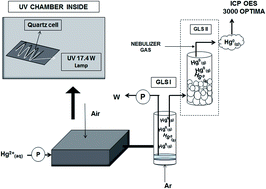Determination of inorganic mercury in petroleum production water by inductively coupled plasma optical emission spectrometry following photochemical vapor generation
Abstract
A photochemical vapor generation system coupled to an inductively coupled plasma optical emission spectrometer (ICP-OES) was used for the determination of inorganic mercury in high salinity water arising from offshore petroleum exploration platforms, i.e., production water (PW). The system comprised a 17 W UV grid lamp for photogeneration along with two gas/liquid separators functioning in tandem to minimize aerosol transport into the plasma. Analytical conditions, including the type and concentration of low molecular weight organic acid, UV exposure time and solution pH, were optimized. Continuous-flow processing of a sample containing 1.63 mol L−1 formic acid at pH 1.5 for a UV irradiation time of 30 s permitted Hg(II) to be determined based on the method of addition. Procedural limits of detection and quantification of 1.2 and 4.0 μg L−1, respectively, were achieved. In the absence of a suitable certified reference material with which the methodology has to be validated, recoveries of 10–40 μg L−1 Hg(II) spikes added to real samples were examined and ranged from 79 to 121%.

- This article is part of the themed collection: Analytical Atomic Spectrometry in South America

 Please wait while we load your content...
Please wait while we load your content...